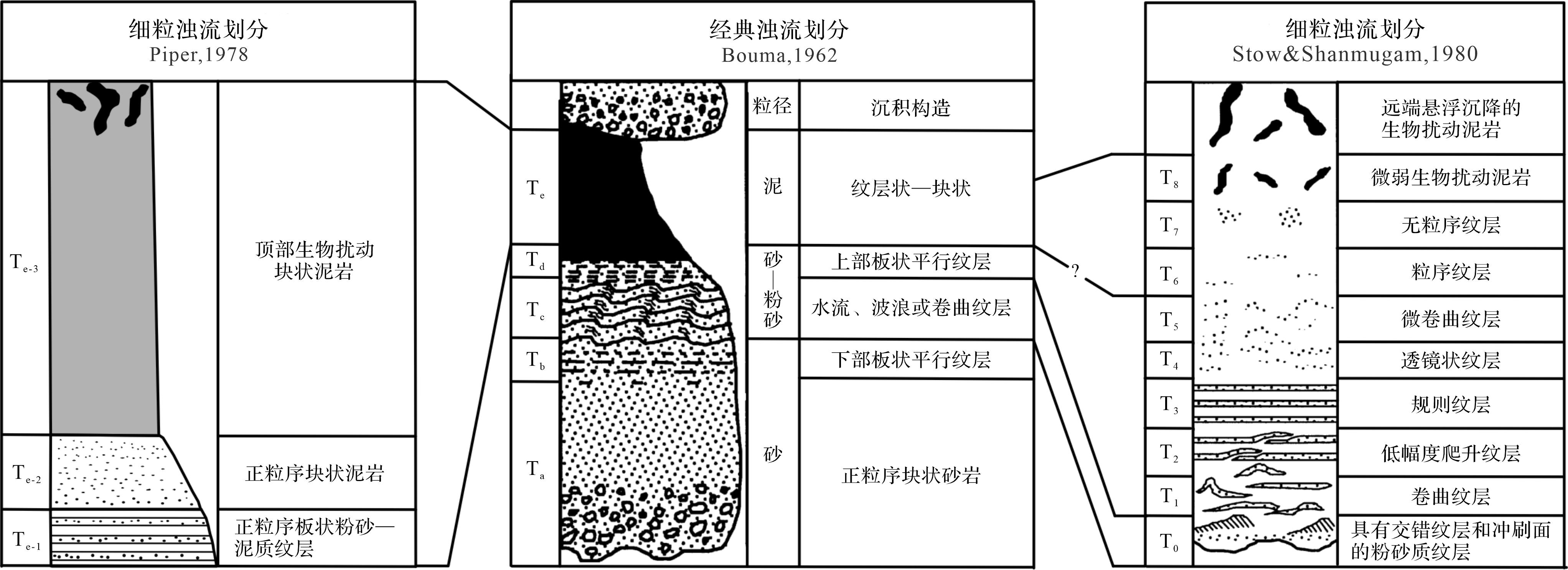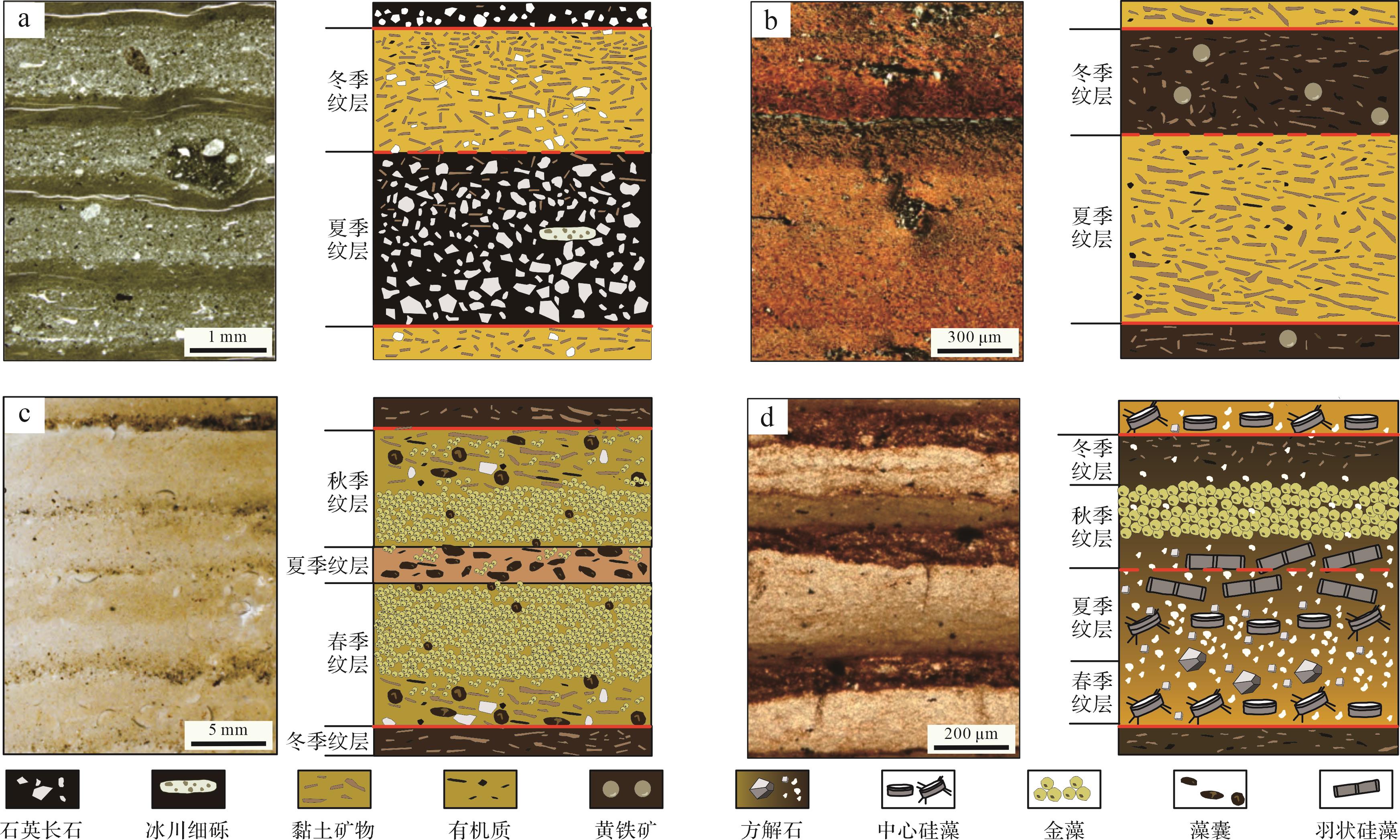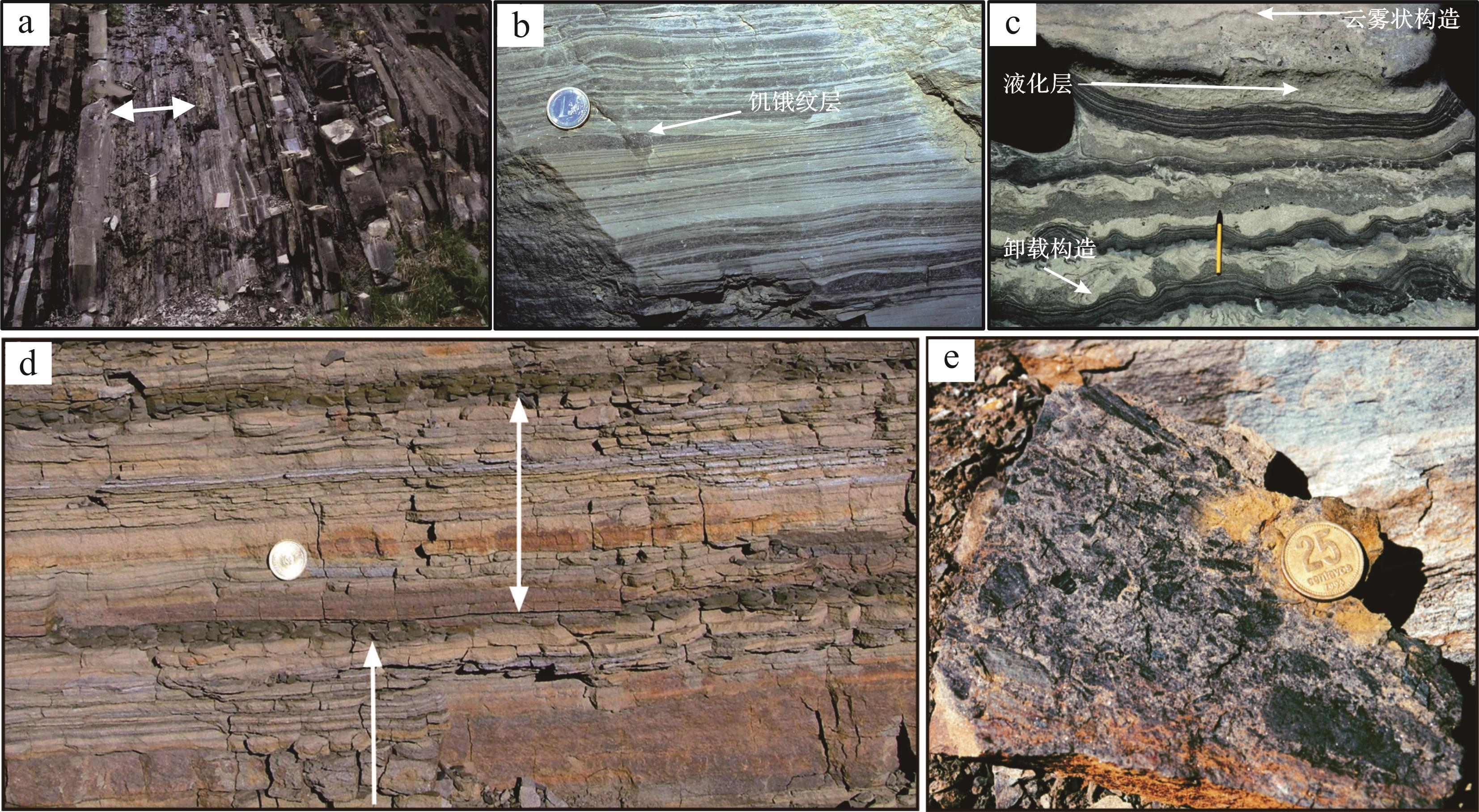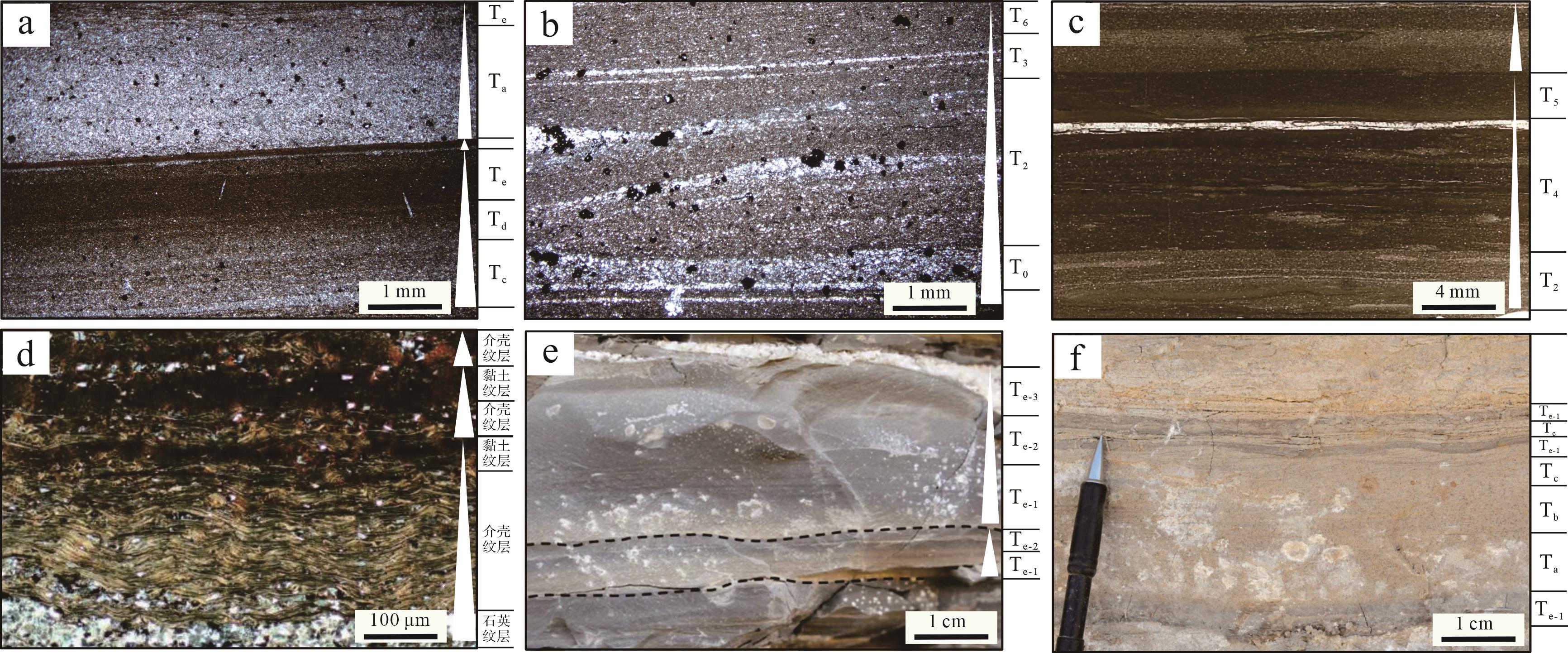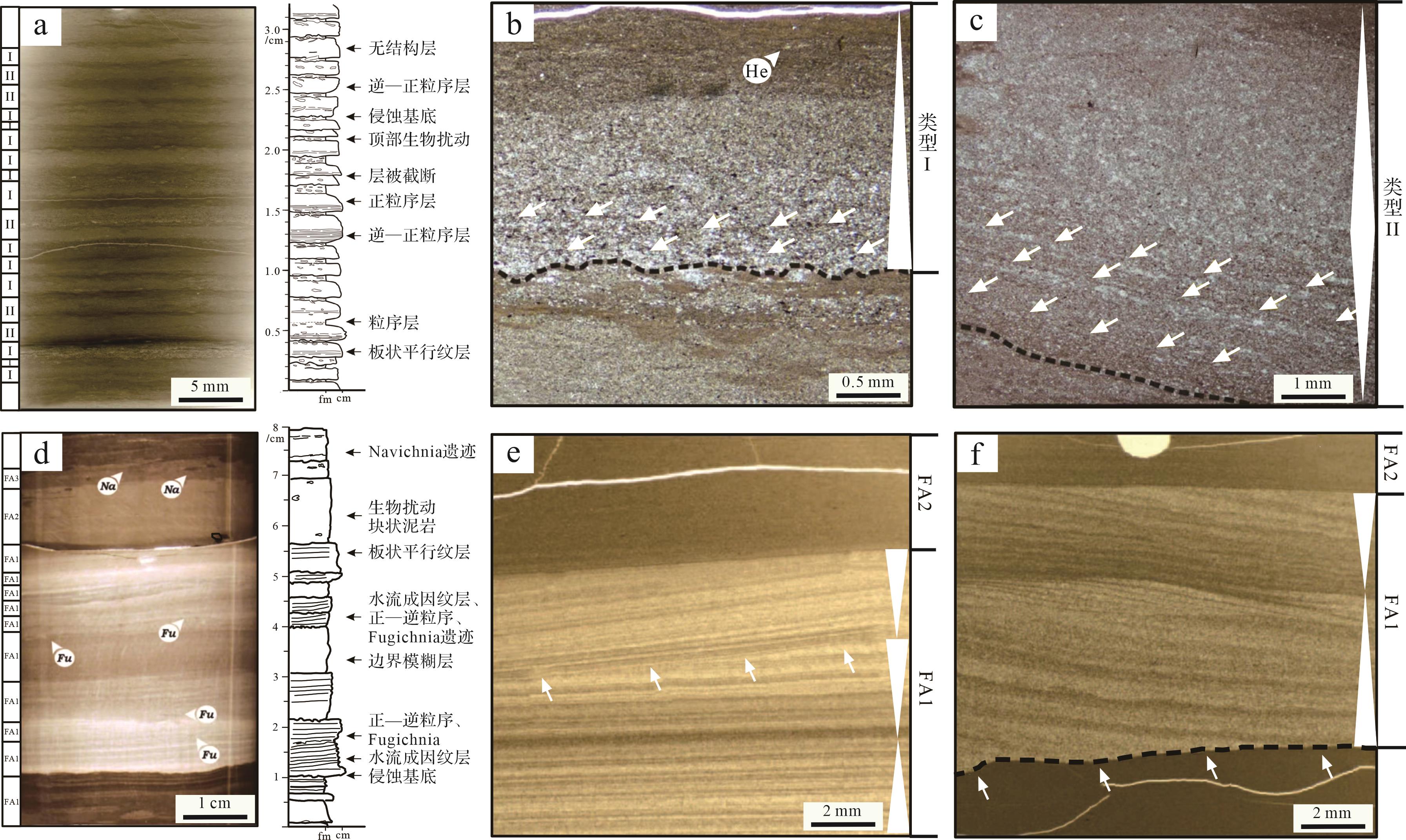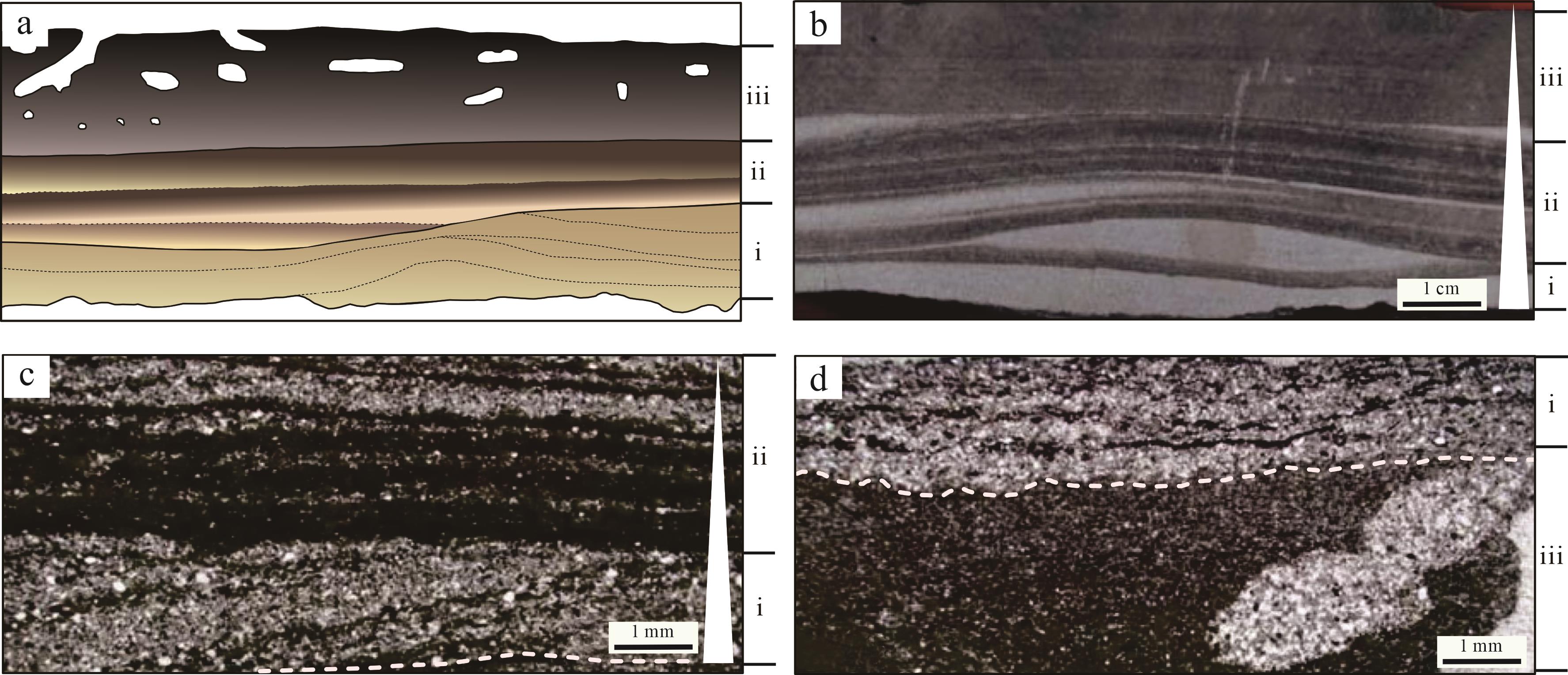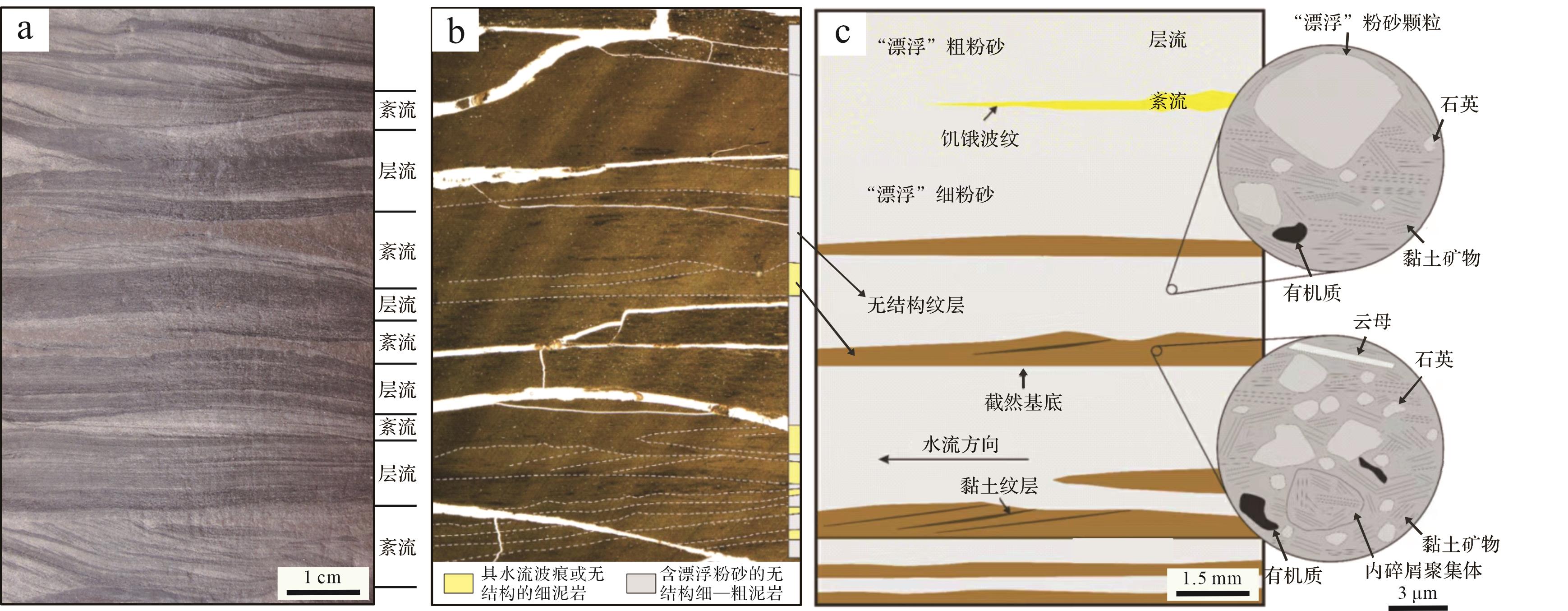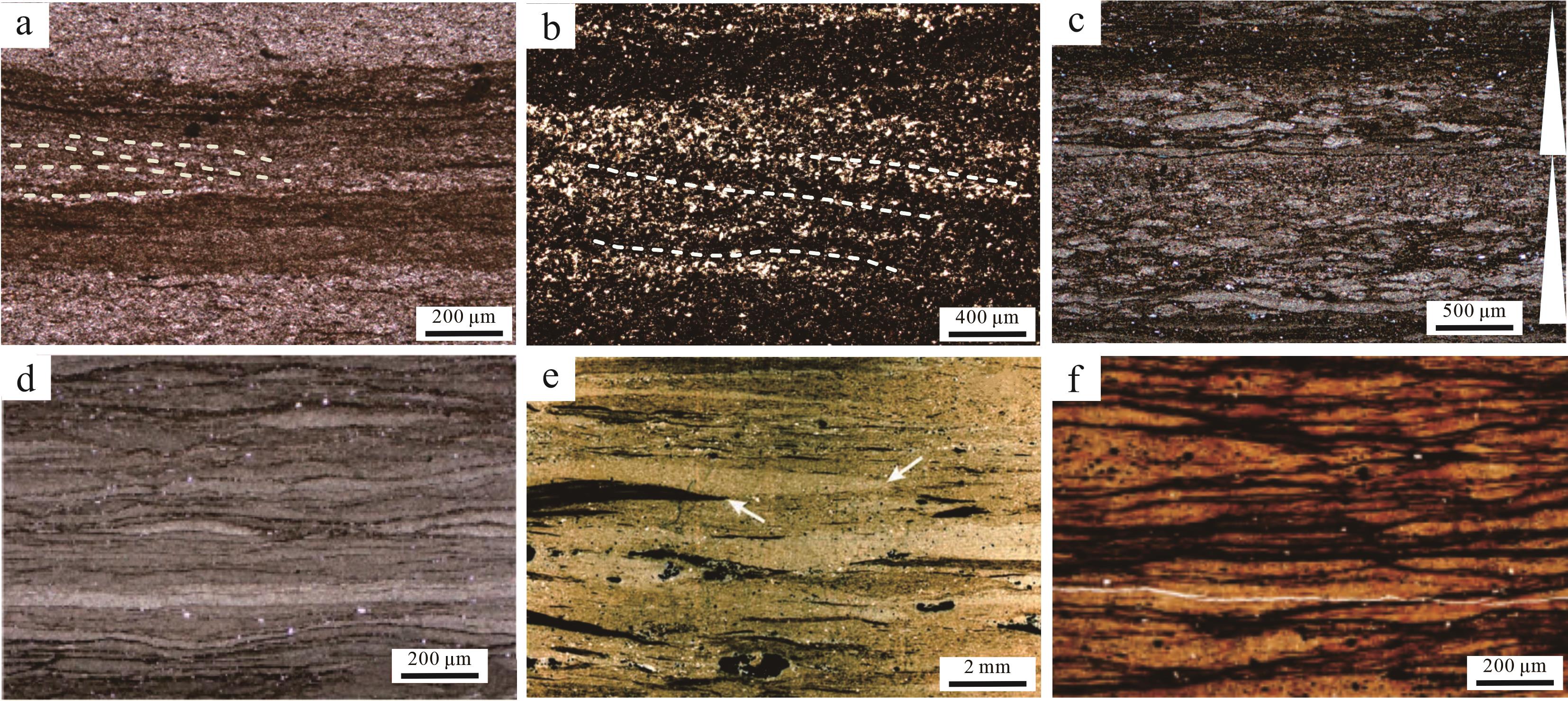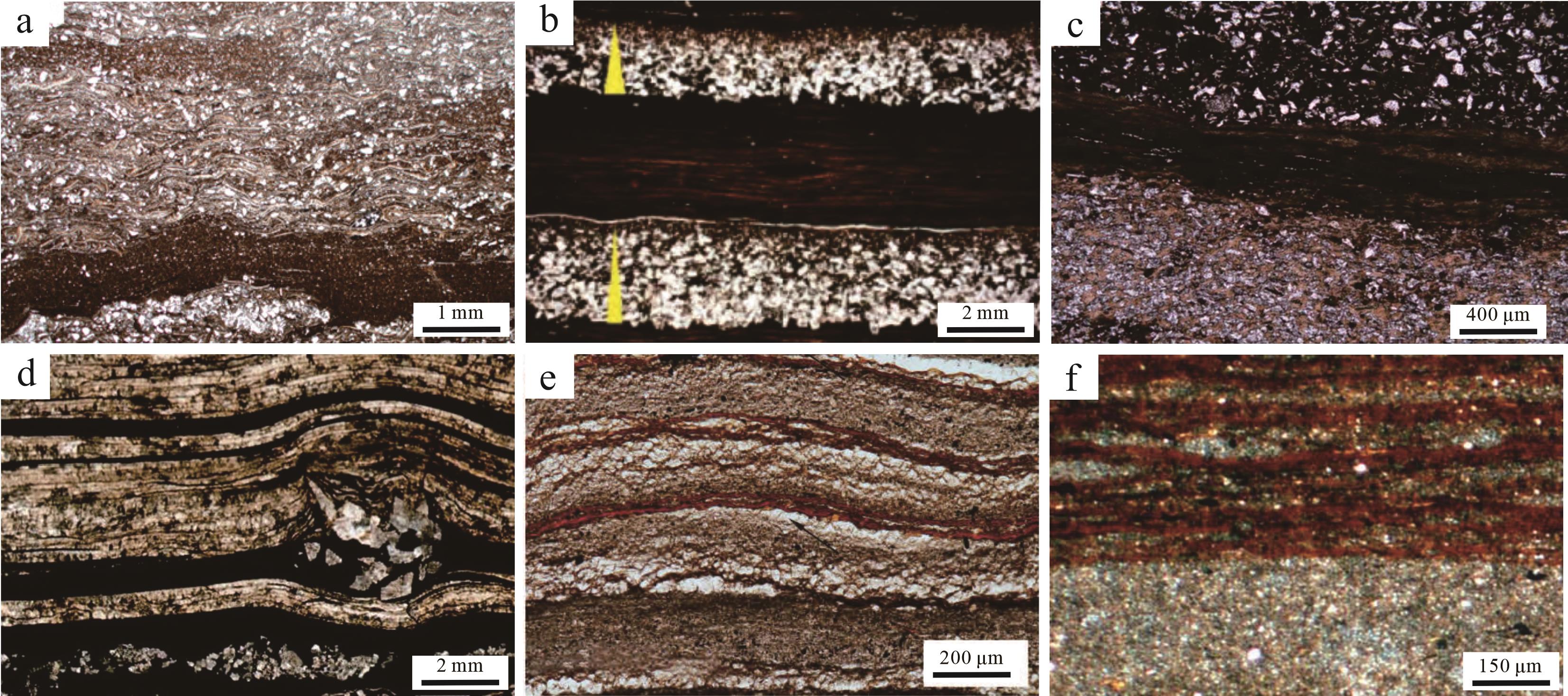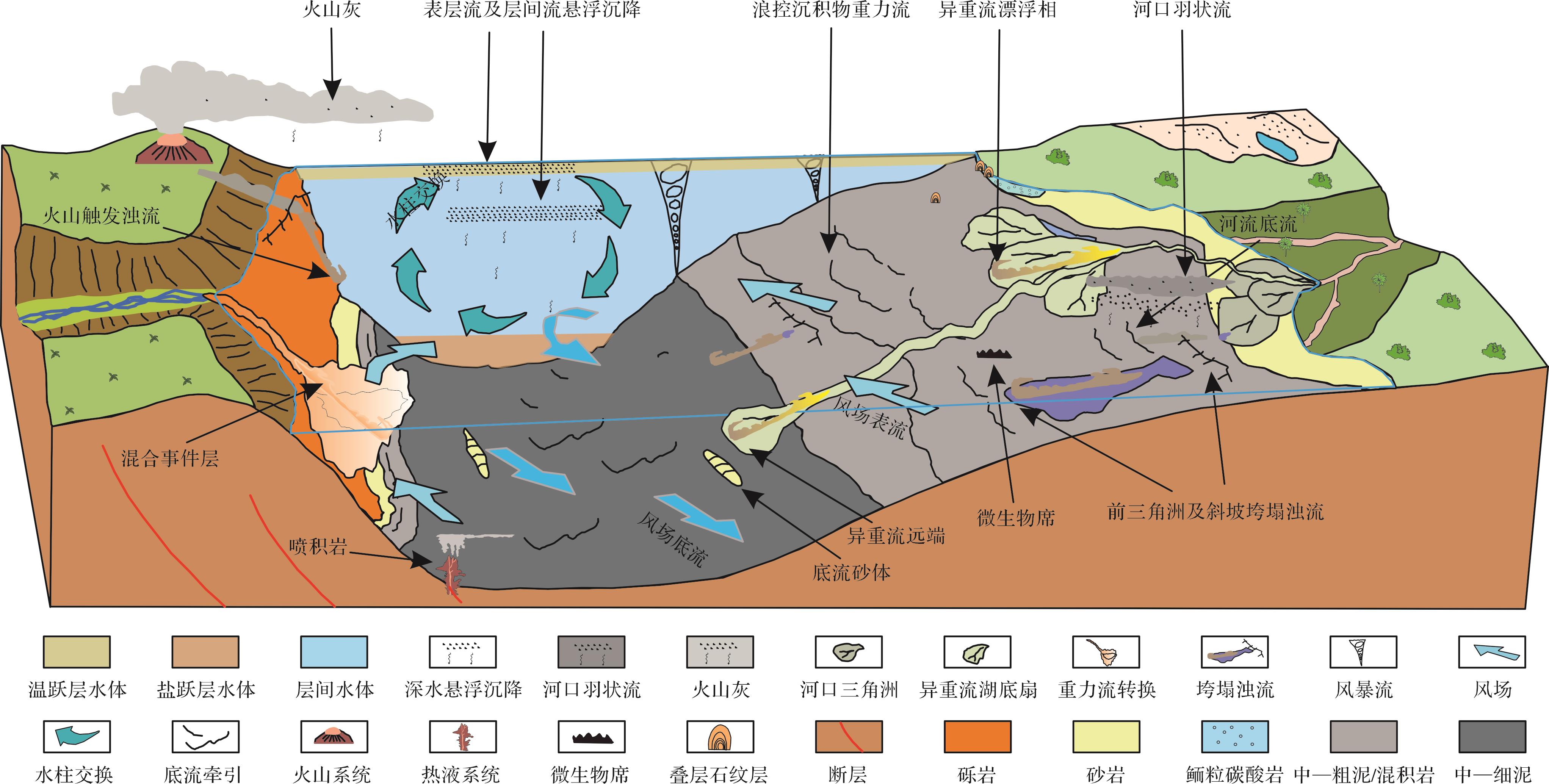HTML
-
细粒沉积岩,又称泥页岩,指主要由黏土级和粉砂级颗粒组成的岩石,作为地球上广泛发育、占比最高的沉积岩,它常发育大量纹层,使岩石表现出矿物成分、结构及颜色等变化[1⁃2]。由于细粒沉积岩不仅蕴含了巨量的非常规油气资源,还是古气候、地球磁场、生态环境重建[3⁃4]及早期生命演化[5]研究的重要载体,因此细粒沉积岩纹层研究备受学者关注[6⁃7]。近年来,细粒沉积岩纹层形成机制成为研究的热点和重点。传统观点认为,细粒物质一般在低能安静环境中缓慢沉积,并由于沉积间断形成纹层[8]。但水槽实验、海洋沉积观测及海相泥页岩的精细观察显示,细粒物质可在底流[9]、异重流[10]、风暴流[11]及浪控沉积物重力流[12⁃13]等多种机制下搬运沉积,形成丰富纹层类型[14]。上述这些纹层形成机制研究进展主要集中于海洋环境,与之相比,湖相细粒沉积岩纹层的形成机制则关注较少[15]。但随着陆相页岩油勘探研究的不断深入,越来越多证据显示湖泊细粒沉积岩纹层也可通过多种方式形成[16],但这些纹层的成因机制尚未引起研究者广泛关注。究其原因,主要是湖泊细粒沉积岩纹层成因类型识别标准尚未建立。在此背景下,本文通过对前人研究的系统梳理,对湖泊细粒沉积岩纹层的形成机制、识别特征及控制因素方面的研究进展进行系统分析,归纳了不同成因纹层识别的特征,并根据目前研究进展,展望了纹层的发展趋势,以期共同推动陆相细粒沉积学发展。
-
纹层是层理中厚度小于1 cm且不可再分的最基本单元[17⁃18],它的沉积机制研究与20世纪以来的湖泊古气候、沉积地质和油气勘探发展密切相关。研究显示,纹层的形成与沉积速率、沉积间断、物质供给及流态转换密切相关,悬浮沉降不是湖泊细粒沉积岩纹层形成的唯一机制,重力流远端稀释及流态转换、底流、火山热液及微生物活动等也可使细粒物质迁移聚集形成纹层(图1)。
-
有关湖泊纹层研究历史最早可以追溯到19世纪中叶瑞典地区冰川湖中的年纹层沉积,后来,de Geer[19]用“纹泥(varve)”一词定义冰川湖泊中较粗浅色夏季纹层和较细深色冬季纹层组成的韵律性年纹层。尤尔斯特图解中,砂级别以下的细粒物质需要在静水环境下依靠重力克服自身的内聚力和水体摩擦力才可缓慢沉降下来形成纹层,因此20世纪以来,人们普遍认为细粒纹层是深水区悬浮沉降的产物。Anderson et al.[20]对湖泊纹泥类型进行归纳,分为有机质—碎屑、有机质—碳酸盐、有机质—蒸发盐、碎屑—蒸发盐和有机质—硅藻五类。悬浮沉降过程中,长英质及部分钙质细粒非黏性物质,满足斯托克定律;黏土及部分钙质颗粒沉积过程中易与有机质组合成团,以絮凝体的形式沉降[21]。
纹泥主要发育在面积小而深且底部相对平坦的深湖中,这些条件有利于水体分层且可避免纹层被后期生物扰动或浊流破坏[22]。而在靠近河口区域,河流或洪水携带的陆源物质进入湖泊可稀释形成羽状流,羽状流中细粒及粗颗粒差异悬浮沉降,可形成不具年度性质的毫米至厘米级的细粒纹层[23]。
-
相比悬浮沉降,重力流沉积速率相对较快,在深湖中多呈块状砂岩将悬浮沉降的纹层状泥岩隔开。但越来越多的研究显示,受物质来源、流体稀释及流态转化等因素影响,重力流也可在其远端形成细粒沉积岩纹层。
20世纪80年代,Piper[24]将Bouma序列Te段细分为Te1-Te3,后来Stow et al.[25]又提出泥质为主的低密度浊流序列T0-T9(对应Bouma序列Tc-Te段),两类划分发育波状纹层、低幅度爬升纹层及平行纹层等沉积构造(图2)。前人对这些纹层成因存在争议,Stow et al.[25]及Talling et al.[26]认为浊流搬运过程中与底床的剪切作用,导致其形成波状、低角度交错及板状纹层,但流体性质仍然为重力流;而Lowe[27]则认为浊流搬运过程中被逐渐稀释,受悬浮沉降和牵引流影响,形成平行和低角度交错纹层。实际应用中,Stow序列细粒浊流虽提出较早,但由于其复杂性未得到广泛引用,Bouma序列及Piper的Te细分是细粒纹层成因的主流理论。近年来,Kong et al.[28]在束鹿凹陷沙河街组等湖相地层研究中将海相低密度浊流纹层成因解释应用到湖泊沉积。

Figure 2. Comparison and division of low⁃density turbidity sequence and classical turbidity sequence (modified from references [24⁃25])
除垮塌型浊流外,洪水异重流也可携带大量物质沿着湖底进行远距离搬运,在咸盐水湖中由于能量减弱及密度反转,牵引和悬浮细粒物质形成具有逆—正粒序的低角度交错纹层及板状纹层[29⁃30]。
此外,碎屑流在湖底搬运过程中,受水体加入、侵蚀及稀释作用的影响逐渐转变为低密度浊流。低密度浊流在搬运过程中,侵蚀泥质基底,使黏土含量增加湍流抑制,进一步转变为泥质碎屑流,两种转变均形成具有多种流变性质流体的“混合事件层”[31⁃32]。Haughton et al.[33]将混合事件层划分为H1⁃H5五个单元,其中过渡流H2段及低密度浊流H4⁃H5段可发育细粒低角度交错、透镜状及板状纹层。
Macquaker et al.[12⁃13]通过对海相泥岩观察发现,风暴或底流作用会使细粒物质再悬浮,并在风浪作用下以重力流形式沿坡搬运形成浪控沉积物重力流,其底部受侵蚀牵引形成低角度交错纹层,上部受紊流抑制和剪切作用形成板状纹层。Bai et al.[34]在渤海湾盆地沙河街组湖相沉积中发现了浪控沉积物重力流。
-
21世纪以来,一系列水槽实验显示,黏土质、长英质及钙质细粒物质在5~50 cm/s高能流速下能以絮状体形式迁移,形成低角度交错纹层[35⁃36]。长英质和黏土细粒混合物在相近流速下同样可以以絮状体形式搬运,由于颗粒之间惰性及动量差异,沉积时絮凝体破裂分离形成低角度交错纹层或平行纹层[9];富水塑性沉积物,受侵蚀形成泥质撕裂碎屑,悬浮、搬运、再沉积形成细砂大小的透镜状纹层[37]。这些实验为风暴或风场等各类底流成因的水流波纹、浪成波纹和混合流波纹及透镜状纹层成因解释提供了有力依据。
1.1. 悬浮沉降
1.2. 重力流远端
1.3. 底流
-
季节性径流携带的陆源物质(石英、长石及黏土矿物)与盆内自生矿物(如方解石或盐类矿物)以表层流或层间流方式悬浮在分层水体中搬运,在相对封闭且安静的半深湖—深湖中沉积下来形成纹层,如果纹层沉积后不遭受改造、保存季节信号并呈韵律出现的纹层称为年纹层或季节性纹泥[44]。
识别标志上,季节性纹泥常呈板状、连续、平行的韵律层偶出现,接触界面截然或渐变(图3)[45⁃49];整体具正粒序,可分为表层流和层间流形成的渐变正粒序及季节性径流、融雪或羽状流缓慢沉积形成的具亚层正粒序(图3b,c)[50];可见漂浮细砾、粪球粒及黏土有机质聚集体等指示悬浮沉降意义物质(图3a)[51];纹层原始厚度介于0.1~1.0 mm,成岩脱水后介于20~100 μm[52];细纹泥(<1 mm)季节性特征保存较好,较浅水厚纹泥(>1 mm)受湖流或者浊流影响可呈缓波状并发育小型交错纹层,甚至被打乱[53⁃54]。纹泥矿物组成受控于湖泊内、外源物质季节性供给,淡水湖以陆源沉积为主,少见碳酸盐沉积。以松辽盆地青山口组过填充阶段为例,在浅湖—半深湖区,夏季河流输入强,颗粒粗,形成浅色粗粒厚层,冬季形成深色细粒薄纹层,组成黏土—碎屑层偶(图3a);在远离物源深湖区,夏季发育黏土等细粒物质沉积,冬季则在强还原环境下发育黄铁矿纹层,形成富有机质黄铁矿—黏土层偶(图3b)[46];在中高纬度湖泊中,春夏秋季不同属种硅藻沉积形成浅色厚层硅藻纹层,冬季黏土、有机质沉积形成深色薄层的黏土纹层,形成生物纹泥(图3c)[55]。
半咸水—盐湖利于碳酸盐沉淀,在半深湖或深湖低能缓坡区沉积成分或组构混积的钙质—有机混合纹泥[56]。由下至上分为三端元:夏季藻类勃发或底栖微生物活动使方解石沉淀,形成浅色钙质厚纹层;秋季藻类死亡,形成有机质纹层,冬季水体紊动性降低,黏土矿物沉淀(图3d)[52]。深湖区由于温度及二氧化碳分压使碳酸盐溶解度增加,使纹层中钙质含量略微降低[57]。
-
沉积物羽流指在湖泊水体中运动的富泥浑浊水体,它可形成三种纹层:一是洪水或河流表层流及层间羽状流,由于湖水盐度、粒径、有机质含量、黏土含量、潮汐等条件变化,在河口的近端稀释卸载形成的薄层或纹层[58];二是砂质异重流远端由于密度反转形成的漂浮相会产生羽状流纹层[59];三是异轻流在湖中心缓慢沉降也可能形成纹层[60]。与纹泥相比,羽状流纹层也常呈平行板状,但层厚变化大(毫米至几十厘米不等),韵律性差(图4a);底部由于微弱水流形成饥饿纹层(图4b);粒度上,异重流漂浮相大于河口羽状流和季节性纹层,为粗粉砂质与泥质互层;接触面截然,可发育液化小型负载构造(图4c)[61]。累计厚度大(可达0.5 m),分布广(图4d);成分上,羽状流携带的陆源细粒物质既可单独沉降,也可在搬运过程中与水体中石英、碳酸盐及有机质等物质絮凝体沉降,形成成分单一或混积纹层;层间含植物碎屑、收缩缝和菱铁矿结核(图4e)[30];生物扰动无或弱。异轻流沉积特征前人已有介绍,其沉积速率慢且分布范围广,与深水季节性纹泥类似,但厚度稍厚(纹层至薄层),生物扰动变化大,有机质及化石类型也存在差别[62],在此不赘述。
-
湖泊中前三角洲或斜坡上细粒物质易垮塌形成浊流。研究显示,低密度浊流沉积时间介于45~90天,形成纹层至薄层状泥—粉砂沉积[63]。低密度浊流除Bouma序列Tc-Te段外[31],还存在Stow序列T0-T7及Piper对Te段Te1-Te3两种划分,选择随实际情况而定(图2)。侵蚀或截然基底、正粒序、微交错层理及透镜状的粉砂—砂质纹层等牵引构造为低密度浊流下部Tc及T0-T3特征(图5a,b),黏土絮凝和粉砂反复分选形成上部板状纹层(可能为Tb、Td、T4-T6、Te1)和悬浮沉降块状泥岩(Te2-Te3)(图5c~e),根据纹层叠置关系和与粒径对比综合确定[48];成分上,浊流形成及演化过程中会搬运源区和路径上细粒物质形成浑浊水体,由于颗粒比重与比表面积存在较大差异使得颗粒沉降速度不同,可能形成较厚层不具生物扰动泥质纹层或成分不同但粒度相同的韵律纹层(图5f)[28]。因此不难看出,层厚、粒度及韵律性不是判断事件沉积的标准,侵蚀基底、正粒序和垂向组合是识别重力流成因纹层的重要标志。
-
据统计,71%的河流输送物质到海洋中会产生中高频率异重流,与海洋相比,湖泊常具水体密度较小、近物源及易受气候影响的特点,使湖泊中异重流触发概率大幅提升[65]。不同于垮塌浊流[66],异重流持续时间长,可进行远距离运移,在远端形成粗粒或细粒纹层[67]。异重流在粒径、厚度、物质来源及地球化学特征等标志与垮塌型浊流均有差别[68]。
沉积特征中,厘米至米级逆—正粒序层是异重流识别的典型标志,记录了能量增强减弱的过程,其中,由于逆粒序不易远端保存且受后期侵蚀,可能只保留正粒序[30];多期异重流可在远端形成韵律性纹层沉积(图6a);混有植物或浅水生物化石(图6b),可见火焰状构造等软沉积变形构造[69];垂向组合上,异重流底部侵蚀牵引,具正—逆粒序的粉砂质水流波纹或板状纹层(类型II及FA1)(图6c~f),沉积后不久,缓慢沉降形成的弥漫深灰色泥质层(FA2),最后,沉积后长时间悬浮沉降的生物扰动泥岩(FA3)(图6d)[10];横向上,近端以具侵蚀基底,发育波浪和水流纹层沉积为主,远端则以羽状流形成含水流波痕的韵律性平行纹层,远近都具沉积后缓慢沉降形成生物扰动泥岩[70];成分上,异重流纹层一般以长英质或黏土质为主,但也可在搬运过程中混合内源物质形成混积纹层。
-
在风暴流或波浪搅动下,沉积物再悬浮以高密度重力流沿坡向下运移,形成风暴流或浪控沉积物重力流[12⁃13]。受风暴发生频率和强度影响,该类纹层主要在海洋及大型湖泊浅湖—半深湖中发育,前人已对其沉积特征进行总结,在此不重复赘述[11]。需要注意的是,浪控沉积物重力流虽也存在与以上两类重力流相似流态转换和垂向组合,整体也具正粒序,但底部多见风暴或波浪作用的低角度交错、丘状或下洼纹层(图7,单元ⅰ)[71];由于湖泊更靠近物源且其风暴或波浪一般小于海洋,因此湖泊中底部纹层一般呈厚度更小、粒度更粗的特征[34]。
-
有关混合事件层组合特征前人已在文章中描述,在此不再赘述[72]。组合上端低密度细粒浊流向远端在迁移过程中沉积稀释,流速减慢,侵蚀能力加强,浓度升高,紊流转变为层流,表现为低角度交错纹层向板状纹层转变(图8a)[73];层流成因的板状纹层中粗颗粒或生物颗粒常“漂浮”在其中[74];实际上,在薄片尺度下,也存在相似的流态转换,在Dunvegan页岩中波状纹层泥岩和相邻无构造泥岩中发现大颗粒“漂浮”在基质中,显示了随着沉积物浓度的增加,从湍流被抑制形成层流(图8b,c)[49]。
-
底流是指湖泊浪基面之下的水体流动,湖泊中存在风场底流、温盐底流及风暴流三种,使沉积物再悬浮、搬运和沉积形成纹层[75]。风场底流是湖泊中表层流和底层流循环引起全湖广泛、大规模水体流动[76];受温度和盐度影响,湖泊表层和底层水体会发生垂向季节性水柱交换,形成微弱、持续温盐驱动的底流[77],由于湖泊面积小,风力整体相比海洋弱,该类底流的水动力是否强到可以搬运细粒物质形成纹层还需要进一步验证;但在如安大略湖及密歇根湖、济阳坳陷沙三下亚段等大型湖泊深水中,均观察到风暴成因底流牵引形成透镜状纹层[78]。
基于现今大型湖泊沉积观测,前人将海洋中风场底流概念运用到青山口组等大型湖泊中,风场底流牵引沉积物形成夹层、爬升交错层理、压扁层理、透镜状层理、平行层理、韵律层理及交错层理等砂质沉积构造[79]。而对细粒沉积,如前文水槽实验所述,在相对高能底流(5~50 cm/s)作用下,细粒物质以富水絮凝体形式底载牵引沉积形成低角度交错纹层(图9a~c)[16,80⁃81],或侵蚀湖底软泥,形成泥质撕裂内碎屑搬运及再沉积,形成透镜状纹层(图9d~f)[37,82⁃83]。温盐底流(水柱交换)常发育在深湖—半深湖环境中,也可能形成泥质透镜状—微波状纹层,由于受季节影响,所形成的纹层可能存在周期性韵律变化(图9d)[82]。
北美海相页岩多沉积于风暴主导陆架环境,前人对风暴流及其底流沉积特征已总结和发表了大量文章,在此不再赘述[84]。大量观测显示,风暴流也存在侵蚀—湍流—层流—悬浮的沉积转换[85],可形成泥质楔形纹层、丘状交错纹层、水流波纹、浪成波纹、混合流波纹、饥饿波纹及水平纹层[86],随水深变化,近端发育丘状交错纹层,中端以浪成波纹和混合流波纹为主,远端则主要发育风暴底流成因的饥饿水流波纹[64]。
2.1. 悬浮沉降纹层
2.1.1. 季节性纹泥
2.1.2. 沉积物羽流
2.2. 重力流远端纹层
2.2.1. 垮塌型浊流纹层
2.2.2. 异重流型纹层
2.2.3. 浪控沉积物重力流型纹层
2.2.4. 混合事件纹层
2.3. 底流牵引纹层
-
研究显示,芦草沟组、延长组等陆相湖盆优质烃源岩常与火山—热液作用伴生,火山喷发形成凝灰质在深水区沉降形成沉凝灰或方沸石等各类纹层[87⁃88]。水下喷发的熔浆或热液与湖水接触后产生水蒸气并释放能量形成粒度极细的碎屑颗粒,形成热液喷积岩纹层[89]。钙质或硅质生物死亡后经沉降、埋藏可发育生物残骸纹层;光照带生物活动黏结细粒物质,形成叠层石或微生物席纹层[90](图10a)。识别特征上,沉凝灰纹层含火山成因石英、长石、火山碎屑、棱角状火山玻璃(图10b,c)[91];成岩阶段,凝灰层中沸石类、伊利石等黏土矿物发生特定比例变化[92];火山灰水解使P、Fe、Mo及V等元素富集,促进浮游生物繁盛,形成有机质纹层(图10c)[38]。水下喷积岩以溢流或脉动式喷发并受压力影响,形成粒度极细且组成单一的纹层(图10d,e)。受湖浪影响,微生物席黏结碎屑或碳酸盐形成刺状、针状及丘状等不同形态叠层石,发育深色波状碳质纹层,内部有黏土和粉砂,微生物席生长偶尔被风暴打断而具正粒序(图10f)[35,93]。
需要注意的是,不同沉积过程可能会产生相似的纹层结构,目前还没有一种方法可以仅凭沉积结构精确区分为纹层成因(表1、图11),因此在识别中,需要结合物质成分、生物扰动及地质背景等不同证据来综合判别。
形成机制 悬浮沉降 重力流远端 底流 其他机制 成因类型 纹泥 沉积物羽流 垮塌浊流 异重流 浪控沉积物重力流 混合事件层 风场底流 火山或热液 微生物 野外或岩心产出 页岩、纹层状泥岩 纹层—薄层状泥岩、页岩 纹层—厚层状泥岩、单次事件从底至顶层厚变小 泥岩、页岩 页岩、纹层状泥岩 叠层石、纹层—薄层状泥岩 粒径 中泥—细泥 粗泥—细泥 砂—细泥,单次事件从底到顶部粒径变细 砂—细泥 砂—细泥 砂—细泥 矿物组成 黏土—粉砂、黏土—黄铁矿、钙质—有机质、生物残骸、盐类—黏土等 黏土、粉砂或钙质—碎屑混积,取决于物质来源、搬运和混合过程 火山成因矿物、有机质 黏土、粉砂、有机质、生物残骸 层厚 几十微米—几厘米 微米—几十厘米 几十微米—几十厘米 几十微米—几厘米 几十微米—几厘米 几何形态 板状、平行、连续 板状—波状—透镜状、平行—不平行、连续—不连续 板状—波状—曲线状、平行—不平行、连续—不连续 板状—透镜状、不平行、连续—不连续 板状—透镜状、平行、连续—不连续 刺状—针状—丘状—波状、平行—不平行、连续—断续 沉积特征 韵律年纹层组合,不同类型湖泊有差异 层厚差别大的平行板状纹层或层、底部透镜状纹层、“云雾状”等软沉积变形、层间植物碎屑 鲍马序列或Stow细粒浊流序列 侵蚀基底、逆—正粒序、低角度交错纹层、板状纹层、顶部生物扰动、植物碎屑 侵蚀基底、正粒序、低角度交错纹层、丘状纹层、下洼纹层、顶部生物扰动 紊流成因低角度交错纹层和层流成因颗粒“悬浮”的板状纹层互层 低角度交错纹层、内碎屑集合体纹层、正粒序 火山成因矿物纹层—有机质纹层层偶、正粒序 碳质纹层,偶尔被风暴打断、生物残骸聚集 生物扰动 0~1 0~3 0~5 0~3 0~3 0~5 0~5 0~1 0~5 沉积环境 深湖—半深湖 浅湖—半深湖 前三角洲、浅湖—深湖 前三角洲、滨湖—深湖 浅湖—深湖(可能) 浅湖—深湖 滨湖—深湖 深湖 滨湖—半深湖 主控因素 水深、构造、风场、水体性质、温度、降水 物质来源、水体性质、风场 构造、水深、物质来源 降水、水体性质、水深、物质来源 气候、构造、水深 构造、水深、物质来源 水深、风场、构造 水深、构造、物质来源 水深、物质来源 Table 1. Classification of formation mechanism and sedimentary characteristics of laminae in lacustrine fine⁃grained sedimentary rocks
-
纹层通常是单一水流或沉积事件在几秒钟到一年或几年的“地质时间的瞬间”形成的[11]。湖泊细粒沉积岩纹层的控制因素包括但不限于气候、地貌、风场、盆底形态、水文、基岩类型、构造等因素[94]。由于各因素之间常相互关联,不完全独立,本文将影响纹层沉积机制和特征的因素分为古气候和古地理两大类,将次要影响因素包含到相关主要因素中一并讨论。
-
温度通过控制水体分层,影响纹层连续性、形态和成分[95]。太阳光照使表层低密度暖水漂浮在底部高密度冷水之上,形成湖水温度分层,利于物质悬浮沉降形成纹层[96]。纬度不同导致的光照差异,热带—亚热带湖泊温度分层能一直存在,如非洲Kivu湖,而高纬度地区,温度分层可季节性消失,受水柱交换或风场影响,产生底流纹层[97]。此外,温度通过控制生物活动或蒸发作用也可使纹层成分发生变化,例如在沙河街组平衡填充咸—盐水湖中的钙质—有机质纹泥或盐类—黏土纹层组合中,夏季高温、水体蒸发和生物作用繁盛使水体盐类达到饱和,形成碳酸盐或盐类矿物纹层,秋冬季生物死亡,沉积有机质或黏土纹层[28]。
-
温度与降水影响水体介质和内外源物质供给,从而控制了纹层成分。一般来讲,湿润气候剥蚀作用加强,陆源输入增加,易形成长英质或黏土纹层;干旱气候下,碳酸盐及盐类纹层则相对富集[98]。例如,在青山口组等过充填型淡水湖中,开放水体一般具有较低pH,碳酸盐溶解度较高,伴随湿润气候使陆源碎屑输入增加,因此长英质占主导,夏季强降水沉积碎屑纹层,冬季低能沉降黏土纹层;在芦草沟组及沙河街组等平衡充填型湖中,夏季降水碎屑输入使浮游藻类和细菌繁盛并蒸发强烈,降低水体CO2分压并提高pH值,使碳酸盐达到饱和度沉积碳酸盐纹层[99],底部卤水滞留可形成盐度分层,其持续时间较温度分层久得多,长期滞留导致氧化还原分层,利于有机质或Fe、Mn等还原态形式保存,形成富有机质碳酸岩或盐类纹层[100⁃101];在准噶尔盆地风城组或土耳其Van湖等欠充填型咸水—盐水湖中,干旱气候下封闭水体一般pH和盐度较高,使碳酸盐溶解度降低,碳酸盐与碱性矿物纹层比例则进一步加大[102]。
湿度和降水通过控制湖平面变化,影响了重力流的纹层类型和分布。阿拉斯加Eklutna湖的现代沉积中,洪水成因纹层一般只发生在春季和初夏,垮塌浊流则不受季节变化影响。在长时间尺度上,受气候—湖平面变化影响,情况有所不同,前人对沙四段地层堆积样式与沉积相分布调查发现,温暖湿润期,湖平面快速上升,异重流易发育;寒冷干旱期,湖平面下降,斜坡暴露有助于触发垮塌重力流[103]。此外,Zavala et al. [104]对洪水相关异重流或异轻流发育特征总结发现,异重流类型受洪水和湖水密度综合控制,而湿度和降水正是控制这两者的关键因素。水体盐度也影响羽状流絮凝作用,导致物质沉积速率发生变化,从而控制纹层的厚度和类型。实验表明,细粒物质在盐度为1~2 g/L时便开始絮凝,达到35 g/L絮凝速率最快,超过40 g/L时沉积速率反而降低[105]。因此,盐度过高或过低时,羽状流均可在风场作用下进行较长距离搬运,有利于形成羽状流纹层[106]。
-
风场通过控制不同深度水体运动使纹层形态和粒径发生变化。一般来讲,板状纹层多形成于能量较强底流或悬浮沉降条件;曲线状纹层常与底流或波浪有关,水体能量较高。波状纹层常与波浪有关,水流能量中等至较低[107]。粒径上,弱水动力条件易沉积黏土质细泥纹层(<8 μm),中等—弱水动力条件易形成细粉砂和碳酸盐为主的中泥纹层(8~32 μm),中等—较强水动力条件易形成粉砂和生物残骸组成的粗泥纹层(32.0~62.5 μm)[108]。
羽状流在波浪、风及湖流等作用下向盆地中心搬运和分选,物质供给减少及水体加深,形成由盆地边界到中心整体呈块状—层状—纹层状分布[109]。大型湖泊风场风浪湖底形态之间作用影响了水流方向,进一步改变纹层分布范围和混积类型[110⁃111]。
综上所述,气候对纹层控制作用广泛而复杂,常通过控制温度、降水、盐度和风场等要素,影响水体分层(氧化还原、密度)、物质供给、重力流触发机制及絮凝速率,使纹层颜色、成分、结构、厚度和分布发生变化。
-
纹层易形成于水体足够深且底部平坦的半深湖—深湖中。足够的水深是抵抗风浪和维持水体分层和物质缓慢沉降的有利条件,因此水深越大越利于纹层形成。一般来说,大型淡水湖—半咸水湖水深需20 m左右可形成纹层,盐湖则稍浅[112]。
十万年到百万年时间尺度上,水深和径流供给控制了湖泊的类型,导致纹层类型发生变化(表2、图11)[113]。以绿河组为例,在过充填阶段,三角洲进积强,水体分层差,深水区以碎屑型、黏土型、生物型及钙质—有机混合纹泥和高密度重力流成因纹层为主,滨浅湖区低能缓坡区可沉积叠层石纹层;平衡充填阶段,盐度较高,碳酸盐生产力和水分层强,半深湖—深湖区以混积的钙质—有机质纹泥、盐类纹层及低密度浊流纹层为主,河口区及滨浅湖发育羽状流卸载及叠层石纹层;欠充填湖泊水位低,盐度大,深水区纹层以盐类、风场及混源纹泥为主,局部底栖微生物席纹层,滨浅湖区沉积悬浮沉降纹层[114]。
湖泊类型 地表—扩张湖 滨湖 浅湖 半深湖—深湖 有利甜点段 过充填淡水—微咸水湖 沉积环境 沼泽、潟湖、砂—泥滩、泛滥平原、火山溢流 湖滩、高能或低能台地、三角洲平原—前缘、火山溢流 斜坡、高能或低能缓坡、前三角洲、火山重力流、河流底流 悬浮沉降(陆源为主,内源及火山灰少)、浊流、异重流(河流或火山)、风场底流、水柱交换、重力流、湖底热液 河流影响强烈、三角洲进积强,盐度低,水体分层差,高密度重力流发育,中到低TOC,植物和藻类有机质,沉积体横向变化截然 细粒纹层 潟湖中悬浮沉降纹层 台地叠层石 斜坡或前三角洲垮塌浊流纹层、缓坡叠层石、浅湖—半深湖悬浮沉降纹层、河流、风场或风暴纹层底流 碎屑型、黏土型、钙质—有机混合(微咸水)及生物型纹泥、浊流、异重流远端及混合事件层纹层、水柱交换及风场底流纹层、沉凝灰及喷积纹层 实例:青山口组、延长组七段非常规:半深湖—深湖钙质—有机质混合纹泥(微咸水湖)、部分凝灰岩及喷积岩纹层常规:深水浊流砂体或生物遗骸沉积、异重流砂体、滨浅湖碳酸盐或混积岩 平衡充填微咸—咸水湖 沉积环境 碳酸盐浅滩、高能或低能台地、三角洲平原—前缘、火山溢流 高能或低能缓坡;前三角洲、火山重力流 内源或混源悬浮沉降为主、浊流、异重流、风场底流、水柱交换、火山悬浮或重力流、水下火山或热液 低能深水为主、水体分层好,藻类有机质,中—低密度浊流易发育,中到高TOC,湖平面变化大,高水位横向连续性好 细粒纹层 浅滩或台地叠层石 叠层石、河口羽状流纹层、异重流纹层、河流、风场或风暴底流、浅湖—半深湖悬浮沉降纹层 钙质—有机质混合纹泥或蒸发盐纹泥、低密度浊流、混合事件层、浪控沉积物重力流及异重流(争议)纹层、微生物席纹层、底流纹层、沉凝灰及喷积岩纹层 实例:芦草沟组、沙河街组三段非常规:浅湖—半深湖钙质—有机质混合纹泥、羽状流、部分凝灰岩及喷积岩纹层常规:深水生物遗骸沉积、滨浅湖碳酸盐、缓坡泥灰岩、重力流砂体 欠充填咸—盐水湖 沉积环境 干泥滩、泛滥平原、河流、风成沙丘、潟湖、火山溢流 盐沼、三角洲平原—前缘、风暴、火山溢流 盐田、前三角洲、火山重力流 多年生盐湖、季节性风场、水下火山或热液 风场影响强烈、水体分层强,低密度浊流易发育,藻类有机质,低到高TOC,湖平面低且变化大,横向连续性差 细粒纹层 潟湖中悬浮沉降纹层、河流在泥滩表面水流纹层 叠层石纹层、风暴在盐沼表面的水流纹层 纹层—层状蒸发盐、悬浮沉降混源纹层、叠层石 蒸发盐—黏土、钙质—有机质混源、季节性风场纹层或纹泥、浪控沉积物重力流(可能)、微生物席纹层、沉凝灰及喷积岩纹层 实例:绿河组Wilkins Peak段、井井子沟组非常规:混源钙质—有机质纹泥、部分凝灰岩及喷积岩纹层常规:三角洲或河流席状粉砂—砂岩、滨浅碳酸盐 Table 2. Sedimentary environment, laminae types and organic matter enrichment relationships in different lacustrine facies
-
构造是控制纹层分布的另一个重要条件,盆底起伏使沉积动力增强,使沉积物快速沉降,不宜于纹层形成和保存。例如在济阳坳陷沙河街组中,陡坡区或地形起伏的湖底,近岸水下扇发育,沉积速率快,不易形成和保存纹层沉积,而湖底地形平坦开阔湖深洼区或缓坡区,沉积速率较慢,沉积富有机质钙质纹层状泥岩[115]。
盆地形态、断层活动和深度控制了重力流(纹层)类型。例如在济阳坳陷沙河街组陡坡带或断层构造活跃期,垮塌型重力流多发育,而缓坡带或断层稳定期,垮塌型浊积扇规模一般较小,湖平面变化明显,异重流则相对较发育[116]。此外,在重力流流态转变与盆底形态、水体深度和盐度密切相关,凹陷湖盆由于水体较浅且密度小,碎屑流还未向低密度浊流转变就在湖底沉积下来[117],而在深大断陷湖泊中,盆地形态和足够水深使低密度浊流可以持续侵蚀向混合流或碎屑流转变形成不同类型的纹层或纹层组合[118]。
-
湖泊中陆源、火山源及内源等各类细粒物质经多种方式在湖泊不同深度沉积形成纹层,不同湖盆类型纹层类型及组构特征差别极大。总体而言,欠充填型盐水或碱湖中,碳酸盐与碱性矿物纹层所占比例大,而过充填型淡水—半咸水湖则黏土及长英质纹层则占主导(表2)[119⁃120]。以平衡充填咸水湖为例,水体较浅、盐度较高水体可提供充足的Ca2+、Na+和Mg2+离子,发育碳酸盐纹层。深水区受温度和二氧化碳分压影响,会在沉积物和水界面“蒸发”沉淀碱性和盐类矿物形成纹层[121]。
受陆源输入强度影响,纹层成分也发生变化,形成成分或组构混积的纹层[81]。但常被忽略的钙质物源在细粒物质供给中可能也起到很大贡献。Schieber et al.[122]在New Albany细粒沉积中观察到碎屑白云石颗粒,绿河组Fossil Butte段两层凝灰纹层之间在浅水和深水区钙质纹层数量和厚度存在极大差别,也可能指示钙质物质来源于富钙径流与盐湖混合沉淀形成[123];在土耳其Van湖中,受钙质径流影响,不管是在高水位湿润气候或低水位干旱气候均会沉积钙质纹层[124]。火山及热液产生的凝灰质纹层的成分及结构特征取决于源区及搬运过程[125]。
物质供给浓度决定了细粒物质沉降的临界速度。水槽实验显示,底流作用下,细粒沉积物浓度从0.03 g/L上升到1~2 g/L时,沉降速度可由10 cm/s增加到26 cm/s[35];羽状流沉降过程中,当黏土浓度从2%上升至4%时,它和有机质絮凝效率可提高一倍,使河口区羽状流对流旺盛,可能诱发浊流[105]。
此外,细粒物质既可以是单一的,也可以是复合的(如絮凝体、泥质撕裂碎屑、岩屑及粪球粒等),其在恢复物源及沉积机制方面有重要意义[126]。在埋藏成岩阶段,受有机酸、温度和压力影响,石英、黏土及碳酸盐类矿物及泥质复合体发生变形、溶解、重结晶及次生加大等成岩转换,进而改变纹层的物质组成及结构[127]。
3.1. 古气候
3.1.1. 温度
3.1.2. 温度与降水
3.1.3. 风场
3.2. 古地理
3.2.1. 水深
3.2.2. 构造特征
3.2.3. 物质来源
-
湖泊细粒沉积岩纹层极大促进了人类对古气候、古环境及细粒沉积学等理论的发展,并随着碳循环、非常规油气勘探乃至行星地质学等研究的不断深入,纹层的沉积机制和特征研究将愈加引起人们关注。从研究现状看,未来在以下几个方面需给予重视。
-
陆相页岩油气勘探显示,纹层状细粒沉积岩的储层性能一般优于层状和块状细粒沉积岩,是非常规油气“甜点”勘探开发的有利岩相[128⁃130]。其中,富有机质细粒沉积岩纹层发育情况及组构特征,更直接影响非常规油气的储层质量和工程品质[46,80]。然而,目前对于细粒沉积岩纹层发育规律和表征方法不统一,使得不同盆地中纹层的结构、储集性能与石油赋存状态等方面评价结果存在很大不确定性。因此,未来在查明细粒沉积岩纹层发育特征和空间变化基础上,利用不同手段对细沉积岩纹层进行表征。岩石学方面,矿物整体含量(XRD)应是岩石描述的基础层次,更需要在薄片或SEM尺度下,利用XRF及QEMSCAN等手段,开展纹层组构特征精细描述[131]。孔隙特征方面,受样品尺寸及分辨率影响,单一实验手段无法有效表征孔隙结构分布,利用SEM、CT扫描、高压压汞及氮气吸附等不同手段对纹层储集特征进行综合分析[132]。油气赋存状态方面,在TOC和热解测定岩石整体含油性基础上,利用激光共聚焦显微镜分析纹层微米级孔隙中不同性质烃类流体分布[133]。纹层成因机制研究手段方面,需继续开展水槽实验和湖泊沉积观测,查明纹层在盐度、水动力条件、物质组成及浓度等多因素作用下的沉积过程[134]。此外,也可利用数值模拟等手段还原纹层在给定参数下(流速、深度、颗粒种类、大小及实验组数等)的沉积—成岩过程,以期更好理解纹层的发育演化[135]。
-
纹层科学的分类系统,对于纹层研究是至关重要的。前人虽依据厚度、颜色、粒度、矿物组成、形状、连续性及有机质含量等要素总结出多种纹层划分和命名方案,但尚未达成共识[136]。纹层科学分类方案需要综合考虑矿物组成(矿物含量、元素组成)、形态特征(纹层组合、侵蚀及粒序)及生物扰动等能够反映沉积过程和沉积环境变化标志,并结合有机质分布及其他地球化学参数特征,对纹层成因及环境进行综合分析[122]。此外,由于沉积解释多解性,不同成因机制识别与划分还需进一步研究,如何能够更加经济、高效、快速地识别不同成因机制的纹层类型,也是未来研究工作中急需解决的问题。
纹层是沉积—成岩过程复合作用的产物,还应重视不同阶段有机和无机控制因素研究。沉积阶段,除加强水槽实验外,在类型上,还应注重异重流、羽状流、低密度浊流、混合事件层及火山—热液等类型纹层的控制因素研究。成岩阶段研究目前主要聚焦于早成岩及后期热演化过程中矿物生成和转变,而对温度、压力及应力等多因素耦合下纹层中有机质与矿物之间相互作用研究也应给予重视[137]。在查明纹层沉积机制基础上,开展湖泊细粒沉积岩的沉积微相、层序地层及旋回地层方面研究,对建立陆相湖泊细粒沉积体系、成因模式和预测储层空间分布具有极大的价值[138⁃139]。
4.1. 面向油气重大需求,改进纹层表征手段,构建标准的纹层研究体系
4.2. 建立科学的分类系统,强化纹层机理研究和细粒沉积学研究
-
传统上,由于缺乏绝对年龄约束,基于纹层的气候研究主要集中于第四纪及现代[140]。但近年研究显示,第四纪之前的古湖泊中细粒沉积岩纹层可以在火山活动、极热事件、厄尔尼诺气候事件等因素控制下,存在十年到万年天文周期韵律变化,结合数值模拟等手段,可恢复古老时间的气候变化及地质事件,具有巨大的应用前景[112,141]。然而,相比第四纪及现代,未来还需在XRF、测井、图像及红外光谱等手段提取纹层各类信号基础上,开发定量—半定量模型,整合纹层从米到毫米尺度变化,结合机器学习及数值模拟等方法来恢复古环境高精度变化[142]。
湖泊作为重要碳储库已是共识,但由于碳埋藏空间变异性大,使目前对埋藏量的准确评估存在困难[143]。纹层结构、成分、类型、有机质特征及周期性发育等特征则详细记录了碳埋藏的空间变化信息,对定量评估湖泊细粒沉积序列中有机碳埋藏量具有重要意义[144⁃145]。此外,在如风城组、绿河组等欠充填咸水—盐水湖中,发育大量含钠碳酸盐等碱性矿物纹层,也是重要的无机碳库[146]。
除气候还原和碳埋藏外,生命演化及火星地质学等前沿热点问题也需查明纹层的沉积机制。例如,湖相叠层石一直被认为是寻找地球早期生命演化的重要载体[147]。但研究显示,有些古老叠层石可能不是生物成因的,而是软沉积变形形成的[148]。因此,利用纹层解决上述问题时,应对纹层形成机制进行准确识别。此外,随着行星地质学发展,人类已对火星上湖泊细粒沉积开展研究[7]。“好奇号”在Gale陨击坑Pahrump段湖相地层细粒沉积中发现蒸发成因的盐类纹层,结合地球化学物源分析,推测湖泊类型为欠充填盐湖[149]。由此不难看出,对细粒沉积岩纹层沉积机制对应特征的理解掌握,也是开展火星等行星地质沉积研究的基础。




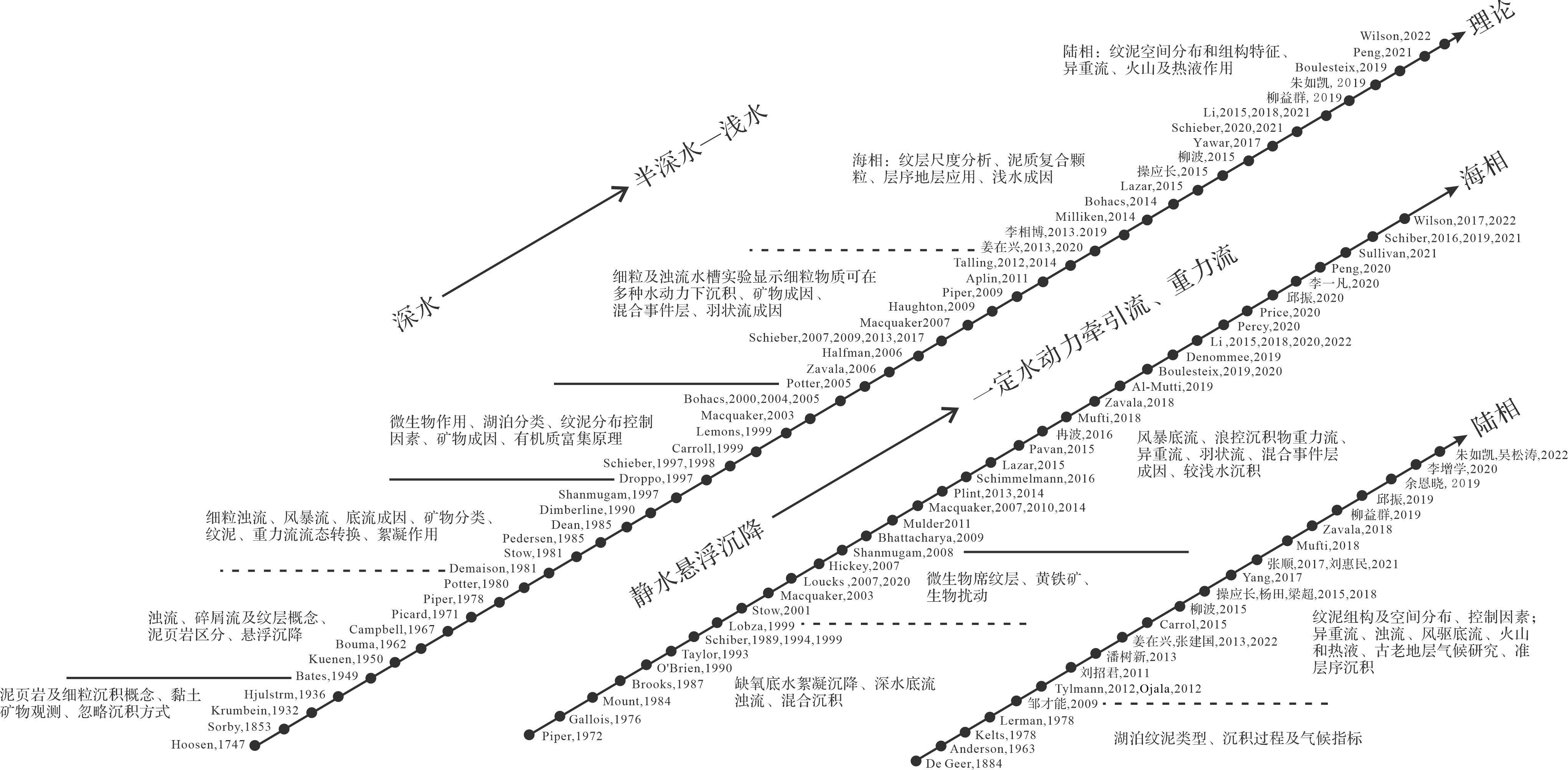












 DownLoad:
DownLoad:
